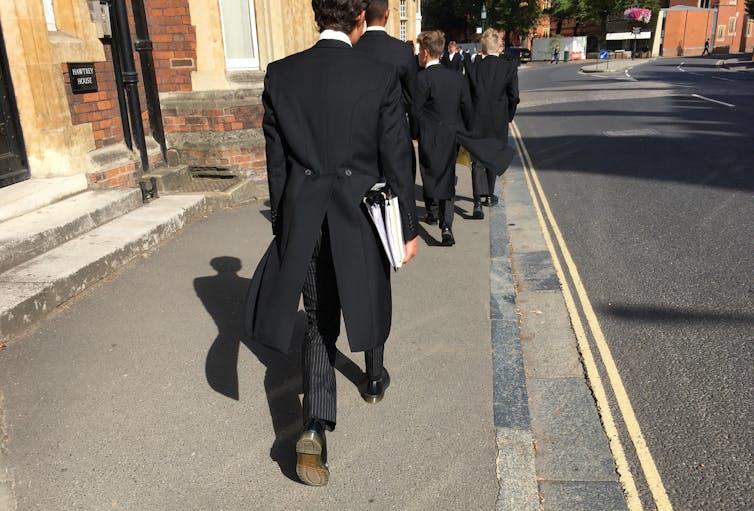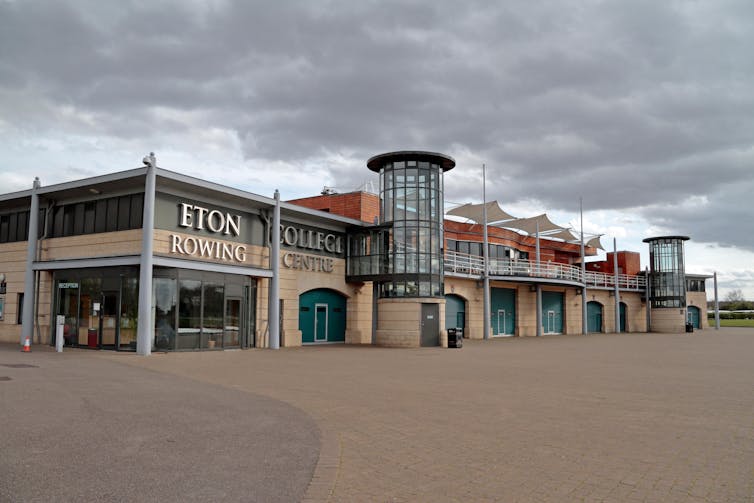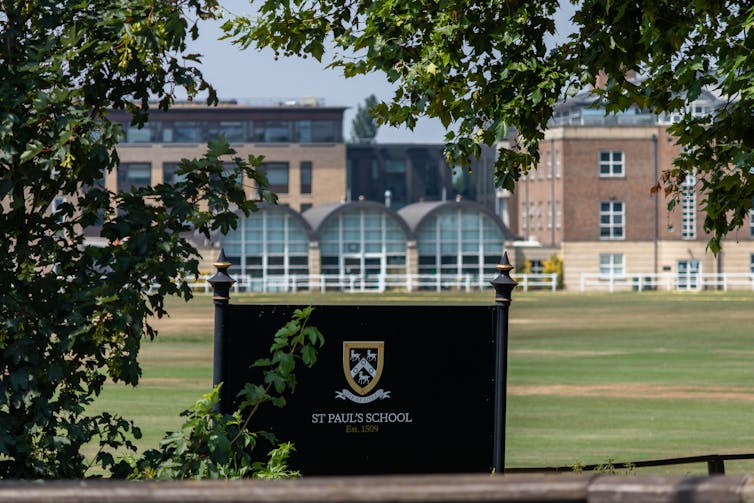
growing expenses and comfort centers elevate questions on charitable reputation
Some UK inner most colleges seem to be profiting from their charitable reputation and the lax criminal definition of “public receive advantages” via charging expenses which can be increasingly more out of kilter with their ongoing prices.
Round 1,300 UK inner most colleges, together with the majority of essentially the most prestigious inner most establishments, revel in long-standing charitable reputation. This offers them considerable tax benefits however obliges them to make use of their charitable assets for public receive advantages.
Our analysis, performed over the past 4 years, specializes in how those colleges gain, maintain and use their wealth, and at the related skinny transparency and duty regimes that experience persevered for greater than a century. (Responses gained are collated on the finish of this newsletter.)
We discovered that a few of these colleges have greater than doubled their expenses over the last twenty years, which seems to signify that they’re pricing via what folks pays, somewhat than their exact prices.
Charging very excessive expenses whilst providing reductions (referred to as commission remissions) that most commonly receive advantages the already-wealthy may also be justified as lawfully charitable and turning in public receive advantages underneath the free regulatory surroundings created via English charity regulation. Moreover, the restricted nature of the extent and achieve of commission remissions is frequently difficult to understand, given their – somewhat respectable – remedy in inner most colleges’ monetary accounts.

This tale is a part of Dialog Insights
The Insights workforce generates long-form journalism and is operating with lecturers from other backgrounds who’ve been engaged in tasks to take on societal and clinical demanding situations.
Whilst lower than 7% of pupils attend inner most colleges in the United Kingdom, in 2020 greater than 31% of scholars at Oxford College have been privately skilled. This instructional disparity is successfully subsidised via all UK taxpayers via a extensive vary of tax exemptions to be had to personal colleges with charitable reputation. The United Kingdom additionally subsidises universities via a roundabout course, which means that privately skilled scholars pay to get get right of entry to to a state-subsidised gadget.
It’s not conceivable to state with sure bet how a lot the United Kingdom’s charitable inner most colleges save via tax exemptions. Alternatively, a excellent estimate in step with our analysis is round £3 billion a 12 months. This equates to greater than 6% of England’s general state college funds (£47.6 billion) in 2020-2021.
In the meantime, the United Kingdom parliament’s Public Accounts Committee reported in March that critically straitened funds have observed many state colleges in England narrowing their curriculum choices, shedding topics, reducing body of workers and lowering enhance for pupils with particular instructional wishes and disabilities.

Contents
- 1 An air of unique luxurious and privilege
- 2 Charitable reputation, public receive advantages and tax
- 3 Personal colleges’ assets of revenue
- 4 How inner most colleges use their revenue
- 5 What constitutes ok provision for ‘the deficient’?
- 6 Who qualifies for personal colleges’ diminished expenses?
- 7 So what might be executed?
- 8 Responses to this newsletter
An air of unique luxurious and privilege
At Millfield, a complete vary of educational and instrumental tuition is obtainable in a purpose-built Song Faculty … Millfield is lucky to have the Johnson Corridor, our 350-seat Live performance Corridor with excellent acoustics and a level sufficiently big to host a complete orchestra and choir. The Johnson Corridor Steinway D Piano used to be not too long ago described via global artist Pascal Rogé as ‘some of the ten highest pianos I’ve ever carried out on’. (Extracted from the Millfield Faculty web site)
Song schooling is culturally and socially enriching for kids, and deemed a very important a part of a well-rounded schooling. Millfield, a high-fee inner most college in south-west England, is a member of the Headmasters’ and Headmistresses’ Convention (HMC) – a formidable foyer staff of personal colleges. Maximum HMC colleges have in a similar fashion ample track choices.
Those provisions stand in stark distinction to the parlous track providing in state colleges. A survey performed via UK Song discovered that fifty% of youngsters at unbiased colleges obtain sustained track tuition, whilst the determine for state colleges is 15%. Moreover, 17% of “track creators” have been skilled at fee-paying colleges, when compared with 7% around the inhabitants as a complete.
The highbrow, cultural and social benefits accruing to personal college scholars via track schooling are echoed in all different curriculum fields, from the appearing arts to recreation to STEM topics.
UK inner most colleges in most cases possess lavish centers and infrastructure. Brighton School commissioned a world-leading architect, OMA – whose different constructions come with the London Design Museum and Moscow’s Museum of Fresh Artwork – to design its new £55m Sports activities and Science Centre. Opened in 2020, it options:
a cinema-style auditorium connected as much as science departments around the globe, 18 university-standard laboratories, six breakout areas for private analysis and tutorials, a 25-metre pool, a energy and conditioning suite, a rooftop working observe with panoramic perspectives, and a double-height sports activities corridor. (Extracted from the Brighton School web site)

A few miles down the street, Roedean Faculty famous of its refurbished boarding centers in 2015 that “every home is embellished with paintings and a palette of Space colors, and complemented with a mixture of new and duration furnishings”.
Roedean has utilised its superlative centers to create an air of unique luxurious and privilege. In a single annual record, the college quoted high-society mag Tatler’s exclamation that “Roedean now has the swankiest boarding centers within the nation, most likely within the universe”. Such abundance is a not unusual function of personal colleges’ advertising and marketing methods.
The expanding asymmetries between state and personal provision in the United Kingdom critically skew instructional, cultural and social results. Such disparities led Finland to outlaw charging for schooling just about 50 years in the past. Against this, some UK inner most colleges have used their charitable reputation and ambitious networks to succeed in a “virtuous cash circle” this is successfully being subsidised via all UK taxpayers, whilst reaping benefits a small minority of predominantly well off households. And whilst they provide some commission remissions for the ones not able to pay their complete expenses, our analysis suggests those typically do little to make the colleges much less unique.
Charitable reputation, public receive advantages and tax
Charities in England will have to have charitable functions, and for greater than 400 years, English regulation has recognised schooling as the sort of goal. Charities will have to additionally ship public receive advantages with their assets – however this time period is best loosely outlined in regulation. This successfully allows inner most colleges to allocate maximum of some great benefits of their land, constructions, centers and scholarships to a small staff of considerably better-off households who can come up with the money for the college expenses.
For a century or extra, charities were exempted from a extensive vary of taxes – a type of public expenditure referred to as “tax expenditures”. Somewhat than amassing taxes after which spending the cash on public services and products, the federal government merely excuses sure categories of taxpayers (on this case, charitable inner most colleges) from paying tax within the first position.
Such tax expenditures are in large part invisible as a result of they don’t seem to be measured, and no particular funds allocations are made and subjected to parliamentary scrutiny. Personal colleges are, in follow, topic to very little duty relating to the effectiveness or fairness with which they use this money.

Shutterstock
Charitable assets supposed for public receive advantages and the really extensive tax financial savings loved via many inner most colleges assist supply sumptuous centers. In flip, younger other folks from households well off sufficient to pay the excessive expenses in most cases achieve disproportionate get right of entry to to most sensible universities and next existence possibilities, partially in the course of the “old skool tie” networks.
Certainly, a consultant of the Previous Marlburian Affiliation (the alumni affiliation for Marlborough School) informed The Instances in 2019 that:
Folks now be expecting that what they pay for isn’t just 5 years of educating however lifetime club to a unique membership. It’s the rationale other folks make a decision to ship their children to public colleges and to not the native academy, the place they will rather well carry out larger academically.
The truth that privately schooled scholars are remarkably over-represented at most sensible universities is, partially, as a result of those colleges’ very important variety criterion is circle of relatives revenue, which typically guarantees that scholars have already got really extensive cultural capital. Different variety standards might come with exams and interviews.
The colleges’ wealth additionally provides their scholars important benefits with regards to an ample provide of high quality curriculum fabrics, small magnificence sizes and extensive educating, plus a possible take pleasure in the colleges’ talent to “sport the gadget”.
The truth that UK upper schooling remains to be considerably state-subsidised ability, in impact, UK taxpayers proceed to fund privately skilled scholars all through their college research. Such scholars’ disproportionate illustration is a significant opportunity-loss for state scholars, lots of whose colleges are struggling actual monetary hardship that negatively affects their scholars’ instructional and occupation results.
Personal colleges’ assets of revenue
Personal colleges have 3 number one assets of revenue.
1. Charges
Charges charged to households are the foremost supply of personal colleges’ revenue. Charges won’t appear a sound public worry – other folks can spend their cash as they please. However the hyperlinks between expenses and the colleges’ charitable tasks wish to be unpacked.
Personal college expenses are excessive relative to reasonable UK earning. In 2018, reasonable annual expenses in day and boarding colleges have been just about £15,000 and £33,000 respectively. In actual phrases, expenses have greater than doubled over the past 25 years. Those worth issues serve to exclude lower-income households. The cost will increase additionally fit marked rises within the disposable revenue of wealthier households in the United Kingdom, and the greater recruitment of scholars from well off in a foreign country households – specifically from Russia and China.
Our analysis demonstrates, empirically, that many inner most colleges price a lot more than is precisely essential for them to fulfil their charitable functions of offering schooling. As an example, evaluating reasonable day and boarding college expenses via area, the diversities between day expenses within the most cost-effective and most costly English areas may just now not be defined via prices by myself. In particular, whilst boarding college commission differentials (17%) have been more or less similar to the variation in related prices akin to staffing, reasonable day expenses within the most cost-effective area have been 35-40% less than the ones in the costliest.
In a similar fashion, we discovered a more potent correlation between native gross disposable family revenue and day expenses than with boarding expenses. This implies that day colleges are specifically aware of the disposable revenue ranges of their catchment space.
However boarding college expenses also are growing hastily, as used to be highlighted in a contemporary Sunday Instances record which recommended the common annual charge of sending a kid to an English boarding college is now “coming near £50,000” because of deliberate commission will increase for the following educational 12 months.
The increasingly more upmarket centers of charitable inner most colleges, akin to the ones described previous, might, in flip, be used to justify those growing expenses. Nearly all of kids from households with extra modest earning are excluded via this commission spiral from playing such centers – which must, via regulation, be to be had for public receive advantages.
2. Tax reliefs
Personal colleges receive advantages financially from the tax exemptions that get up as a result of their charitable reputation. Their working surpluses (earnings) and capital positive aspects (earnings at the gross sales of investments together with stocks, land and centers) are exempt from revenue tax, capital positive aspects tax or company tax.
In England and Wales, inner most colleges additionally obtain an 80% cut price on industry charges (native taxes). Moreover, they are able to declare 25% of all donations gained (akin to chancellor Rishi Sunak’s donations to his old skool, Winchester School, which reportedly exceed £100,000) from the tax government in present support.
This suite of tax exemptions arose mainly from a criminal and public marketing campaign performed via the Headmasters’ Convention within the early twentieth century, and feature remained in large part unquestioned ever since. Charities that offer schooling also are, underneath a 1977 EU Directive, exempt from charging VAT, whilst bequests to varsities are exempt from inheritance tax.
The entire scale of those tax expenditures is most commonly unknown. The Labour Celebration estimated the yearly price of VAT forgone via the state from charitable inner most colleges used to be £1.6 billion in 2019. In 2021, it estimated the yearly price of those colleges’ industry charges cut price and revenue tax aid to be round £100m and £700m respectively. In all, we estimate the full price of personal college tax exemptions might be within the area of £3 billion a 12 months.
3. Investments and donations
Many inner most colleges derive considerable revenue from invested price range and donations. A few of this revenue is derived from similar charities whose goal is to fund particular inner most colleges, however which can be separate for criminal and accounting functions. Regardless of the supply, this revenue is charitable in nature and will have to legally be used for public receive advantages.
In some circumstances, inner most colleges grasp important funding portfolios accrued over lengthy classes of time. As an example, the printed monetary accounts of Eton School and Winchester School display they’ve general reserves of £323,000 and £526,000 according to student respectively.
In regulation, such investments will have to have a charitable goal. But Eton, regardless of expenses of £42,500 according to scholar, nonetheless has to make use of funding revenue to assist fund its spend on schooling. In respond to a request for remark in this article, the college showed: “The volume Eton spends on schooling isn’t met totally via commission revenue; a vital share of that expenditure comes from revenue from our endowment.” This implies the college makes use of revenue from charitable belongings to subsidise instructional provision that it already generously price range via expenses.
Assets of donations and costs
Around the inner most college sector as a complete, it’s price bearing in mind whether or not the assets of donations and costs are at all times respectable, and if the prospective exists for cash laundering. In 2018, the United Kingdom’s Nationwide Crime Company (NCA) asserted that cash is being filtered via British inner most colleges, and criticised colleges for failing to flag suspicious bills to the federal government.
The hot sanctions put on Russian electorate following the invasion of Ukraine once more put a focus at the assets of college expenses and donations – there are some 2,300 Russian kids these days learning in UK inner most colleges. Alternatively, those colleges aren’t legally obliged to record suspected cash laundering, and may additionally have restricted capability to hold out exams.

How inner most colleges use their revenue
UK inner most colleges are, at the entire, replete with monetary assets. As a result of they’re charities, they can not pay out dividends (they’ve no shareholders) and their freely to be had (“loose”) reserves will have to, in regulation, best be enough to allow them to hold out their charitable targets.
Their closing “limited” reserves are price range which can be held for charitable functions – akin to saving for a brand new construction or investment bursaries. However charity regulation and accompanying steering aren’t prescriptive, and easily require trustees to formulate reserves insurance policies that justify a goal point of reserves, and provide an explanation for how they intend to succeed in that focus on.
The accounting company BDO has recommended that, throughout all charities, reserves insurance policies are a long way from adequate. In relation to inner most colleges’ accrued reserves, there seems to be little motion (or urge for food) from the Charity Fee to handle this factor. In brief, those charitable colleges are loose to amass money and feature important discretion as to how it’s used.
A technique to soak up money that can’t be rather saved as loose reserves is to include it into extra centers of the sort described previous. Funding in sumptuous infrastructure tasks appeals to the colleges’ goal markets, doubtlessly enabling them to price even upper expenses.
Whilst an in depth research of colleges’ expenditure on infrastructure is problematic, because of the unpredictable nature of such expenditure and the trouble in distinguishing it from commonplace infrastructure renewal, the upward thrust in inner most colleges’ general annual capital expenditure from £247m in 1997 to £771m in 2013 (the most recent dependable determine) helps this research.
What constitutes ok provision for ‘the deficient’?
English regulation calls for that charities supply advantages to a minimum of a vital segment of the general public. Alternatively, the Charity Fee advises that what constitutes “important” is an issue of judgment.
In a landmark case in 2011, the United Kingdom’s Higher Tribunal dominated that the regulation “calls for that those that take pleasure in the charity’s goal will have to be sufficiently a lot of to represent ‘a bit of the general public’”. Whilst school-age kids clearly represent a vital a part of the general public, commission ranges exclude an overly huge share of them. How, then, are inner most colleges now not in breach in their public receive advantages tasks?
The Higher Tribunal dominated that, in making ok provision for “the deficient”, attention must be given as as to if the charity in query supplies a “luxurious” carrier. Its judgment said that, whilst the availability of luxurious centers is not any bar to charitable reputation, there’s a larger onus on inner most colleges to display how they supply a public receive advantages.
Alternatively, Charity Fee recommendation does now not prescribe any limits both to the level of luxurious that may be equipped, or the utmost point of fees. And the Higher Tribunal dominated that “the deficient” does now not simply come with those that meet legit definitions of poverty. Its definition prolonged to these of “modest ability” – outlined as those that may just now not come up with the money for the college’s complete expenses. Given the present excessive ranges of college expenses, such households could also be a long way from deficient via legit measures.
Learn extra:
Would abolishing inner most colleges actually make a distinction to equality?
Crucially, choices as to what constitutes ok provision for “the deficient” are on the discretion of person college trustees. Charitable inner most colleges keep on simply the precise facet of a fuzzy criminal line in deciding who advantages from the assets they generate from expenses and different revenue assets, akin to tax reliefs and funding revenue.
However, those colleges got quick shrift via the Higher Tribunal in 2011 for disagreeing that, just by relieving the state of the price of instructing their scholars, they have been turning in public receive advantages. And whilst many inner most colleges permit native communities to make use of their centers, akin to swimming swimming pools, the Higher Tribunal wired this doesn’t supply public receive advantages because it has no direct instructional goal. With its more moderen plans to sponsor selective academy colleges, Eton School would possibly fare larger on perceived public receive advantages provision.
Who qualifies for personal colleges’ diminished expenses?
Most commonly, charitable inner most colleges search to display their public receive advantages via commission remissions and entire exemptions. Those could also be means-tested, awarded according to educational, musical or wearing ability, or given as reductions for households with a couple of kid on the college, or to the kids of body of workers. Once more, those choices are on the trustees’ discretion, throughout the regulation.
In 2011, the Higher Tribunal set no minimal point of general commission remissions, stipulating best that it will have to be greater than “simply token”. Our research unearths that during 2018-19, UK inner most colleges awarded commission remissions totalling simply over £1 billion to 176,234 out in their 537,315 scholars. Research of all commission remissions awarded via the 192 HMC colleges in 2019 displays a mean price of 10.4% of general expenses.
Of this £1 billion, some £440m – 44% of the full commission remissions – used to be means-tested. The percentage of expenses discounted in this foundation ranged from 1.7% to fifteen%, with the median at simply 5.1% (for the 142 HMC colleges the place the means-tested cut up might be recognized). In all, our analysis displays the means-tested £440m used to be shared between 44,395 scholars – a mean of round £1,000 a head.

Shutterstock
Simply 6,118 – 1.1% of all inner most college scholars – gained a complete scholarship, and an extra 2.1% gained commission remissions in way over 75% of expenses. Of the colleges contacted all through the writing of this newsletter, St Paul’s Faculty highlighted that 80% of its 147 bursaries are for between 75%-100% of the costs, and Eton highlighted that within the 2020-21 educational 12 months, 90 of the 261 boys receiving commission remissions paid no expenses in any respect. In line with our analysis, those are uncharacteristically excessive percentages when compared with the nationwide reasonable.
Importantly, whilst inner most colleges could also be proud in their scholarship provision, maximum supply no knowledge at the demographic profiles of recipient scholars, making it unimaginable to guage the level to which those receive advantages much less well-off households. And given the excessive ranges of expenses, maximum scholars in receipt of means-tested commission remissions will nonetheless require very considerable circle of relatives contributions.
For example, St Paul’s gives commission help to households with an annual family revenue of lower than £120,000, which will arguably be justified when the definition of “modest ability” is being not able to come up with the money for expenses of round £27,000 a 12 months out of post-tax revenue.
Charging very excessive expenses and giving commission remissions which most commonly receive advantages those that might be thought to be to be already well off can undoubtedly be justified as lawfully charitable and as turning in public receive advantages. However that is as a result of the free regulatory surroundings created via charity regulation and related accounting laws, and as a result of a easy loss of public transparency and duty within the gadget.
Learn extra:
Eliminate inner most colleges? We might be larger tackling inequalities between state colleges
Moreover, the restricted nature of the extent and achieve of commission remissions could also be obscured via their – somewhat respectable – remedy in inner most colleges’ monetary accounts. As an example, if complete expenses are £15,000 according to 12 months and a 50% deduction is awarded, the colleges display (both at the face of the Source of revenue & Expenditure account or in a be aware) gross expenses of £15,000 and the remission of £7,500 as a deduction from that determine. Alternatively, the extra charge to the college of educating that student might be less than the valuation positioned at the commission remission, as a result of colleges’ prices are in large part fastened or stepped (for instance, when an additional instructor is needed). However there may be, after all, a possibility charge to the college of changing a full-fee position with a scholar paying a discounted commission.
There’s a relative dearth of duty across the funds of charitable inner most colleges, regardless of the general public investment they obtain via tax reliefs and their public receive advantages tasks. The United Kingdom govt collects no knowledge at the price of tax expenditures gained via the colleges, and our research of the (restricted) scale and distribution of personal college scholarships used to be highlighted within the Space of Lords in Would possibly 2021 as a purpose for worry.
Discussing the personal college sector, Andrew (Baron) Adonis stated in his speech that “what begins off as a vastly privileged sector, even within the paintings that it does this is intended to be charitable – in relieving expenses and giving get right of entry to to those charitable belongings – isn’t assembly the ones targets”.
So what might be executed?
The financing of the United Kingdom’s charitable inner most colleges is an issue of public hobby and worry. Those colleges have public receive advantages tasks referring to their use of charitable belongings, but some expenses point out that non-public colleges are indulging in marketplace pricing, aside from just about all however the wealthiest from any charitable receive advantages. As well as, the colleges obtain considerable advantages via being exempt from quite a lot of taxes.
Given the present state college investment disaster, it may be argued that instructional assets are being misapplied because of inner most colleges’ charitable reputation, exacerbating instructional inefficiencies and social injustice. For any person in search of to handle those problems, our analysis leads us to the next conclusions:
(1) The United Kingdom govt must introduce tough methods of transparency and duty for charitable inner most colleges, referring to how their charitable belongings are used and via whom, and the level and distribution of the tax reliefs the colleges revel in. As an example, inner most colleges might be required to record demographic knowledge at the recipients in their public advantages at the side of the result of unbiased stakeholders’ critiques. Collated nationally, such knowledge would supply a very powerful enter into debates on schooling investment.
(2) The United Kingdom govt must additionally imagine retreating the tax exemptions loved via those colleges (Scotland has already withdrawn their industry charges reductions). In 2020-21, general spending on state colleges in England and Wales used to be £47.6 billion. If tax exemptions for personal colleges, have been got rid of, the ensuing greater taxes might be redistributed to state colleges, expanding their funds via round 6%, thereby making a vital contribution to the federal government’s levelling up time table.
(3) The charity reputation of those inner most colleges must be reviewed. They’re, for essentially the most phase, elite organisations turning in a paid-for and unique product. The level to which this meets public perceptions of “charity” is questionable. After all, removing of charitable reputation would imply making new preparations for the belongings the colleges grasp, as they may now not legally retain keep an eye on of charitable belongings akin to investments and constructions. Regulate of those belongings may well be transferred to, say, a countrywide schooling believe for the good thing about all UK college scholars. Partly, this might be accomplished via renting again the constructions and centers to the personal colleges the place they’re positioned, with the condo revenue raised then being dispensed right through the state college gadget.
(4) In any case, upper schooling insurance policies on college get right of entry to wish to in particular deal with problems related to the disproportionate illustration of personal college scholars. The United Kingdom govt has, for a while, faithful really extensive assets to widening upper schooling participation, with its primary insurance policies encouraging deprived scholars to realize get right of entry to and succeed in luck. Such insurance policies successfully forget about the chance prices borne via state skilled scholars as a result of charitable inner most colleges’ tax exemptions and different advantages.
Any makes an attempt to impact trade will, alternatively, inevitably be met with important pushback. Over a minimum of two centuries, the United Kingdom’s inner most colleges have effectively mobilised charity and tax regulation to their benefit. But this workout of energy is successfully invisible to wider public view, because of the complexity of criminal linguistics and processes, the pseudo-objectivity of the regulation, and the failure of parliament to make public expenditure on inner most schooling an issue of standard debate and duty.
All colleges named on this article have been presented the chance to touch upon its key findings. The next colleges presented feedback, which can be summarised right here:
Eton School
“The volume Eton spends on schooling isn’t met totally via commission revenue; a vital share of that expenditure comes from revenue from our endowment. In our closing monetary 12 months to 31 August 2021, Eton spent £7.081m on monetary support. 261 boys at Eton (19%) gained commission discounts; 90 of those boys paid no expenses in any respect. This 12 months, that quantity is 103.
“We paintings with various exterior companions, together with the Royal Nationwide Youngsters’s SpringBoard Bursary Basis, to make certain that our bursary programmes achieve those that would maximum receive advantages. Since we’re closely oversubscribed via folks prepared to pay the entire commission, those prices are actual prices, which we’re proud to fulfill.
“Eton additionally has a big and increasing partnership programme. We’re about to open 3 new state sixth-form faculties in partnership with Superstar Academies, which Eton will assist to fund in perpetuity. We record detailed annual accounts with the Charity Fee. Those are scrutinised via our Audit Committee and via our complete governing frame, along with being externally audited. Our Reserves Coverage is ready out in our printed accounts.”
St Paul’s Faculty
“Our Governors and committees are very working on reserve ranges, public receive advantages and duty – our folks be expecting it. For the following educational 12 months, we’re having a look at a commission building up of three.5%. This building up follows the verdict of the governors to extend all body of workers salaries via 3%, with an extra quantity for lower-paid body of workers contributors with a view to meet cost-of-living will increase. The Governors have a said dedication to check out to restrain our commission will increase to stay in step with, or under, inflation.
“Charges rebates have been equipped all through the primary time period of COVID far off studying (summer season 2020) and once more within the 2021 spring time period (which many fogeys donated again to our bursary enchantment). Relating to households with modest earning being excluded from commission remissions, 80% of our bursaries are for 75-100% bursaries, which means nearly all of the 147 bursaries these days awarded are for the ones maximum in want. Charge remissions are proven as a deduction from gross commission revenue within the notes to the accounts, after which the remissions coming from limited donations are added again – our working out is this is identical for all unbiased colleges.
“In the case of ‘loose reserves’ (reserves which can be straight away to be had to spend), the college has none as a result of our unrestricted reserves are tied up in constructions which, as you are going to perceive, aren’t straight away realisable. As a charitable basis we aren’t pushed via benefit, however similarly we’re dedicated to keeping up the assets of the college and the excessive instructional provision which we have been based in 1509 to offer. Our partnership paintings in the course of the West London Partnership – which we established – is considerable and rising.”
Roedean Faculty
“In the case of our boarding centers, the homes have been in dire want of refurbishment as they’d now not been refurbished for a few years and in addition required structural paintings to the construction. Any residential lodging wishes to fulfill the specified requirements for boarding. We do put pupils’ paintings at the partitions and Space colors (purple, blue, inexperienced, yellow) are used within the Properties, at the side of furnishings (new and outdated). The Properties are the women’ ‘properties’ and we wish all women to really feel at house right here. Tatler’s citation displays their mag’s genre.”

For you: extra from our Insights collection:
To listen to about new Insights articles, sign up for the masses of 1000’s of people that price The Dialog’s evidence-based information. Subscribe to our e-newsletter.
Supply Via https://theconversation.com/the-public-cost-of-private-schools-rising-fees-and-luxury-facilities-raise-questions-about-charitable-status-182060

